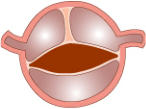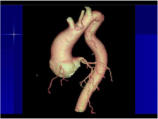


Disclaimer Privacy Policy
Copyright (c) 2021 Bicuspid Aortic Foundation, All Rights Reserved


Creating a Climate of Hope, an Atmosphere of Caring, and Information for All

BAV in the Spotlight
Focusing on
Bicuspid Aortic Valve

A - Accurate Diagnostic Testing
Accurate testing is critical in order to understand the condition of the
chambers of the heart, the heart valves, and the aorta. Depending on the
risk factors involved, the blood vessels of the head and neck may also be
examined.
The emphasis must be on accuracy, both in the quality of the tests and in
their interpretation.
It is important to have tests interpreted by experienced aortic treatment
centers.
These tests are extremely important both for you and your physicians.
They are the basis for aortic disease diagnosis and treatment.
Echocardiogram
An echocardiogram is often the first test used to screen for aortic disease.
When done through the chest wall, (transthoracic echo), it is non-invasive.
Sound waves are used. There is no exposure to radiation of any kind, and
no contrast is needed.
This test generally:
•
shows how well the heart valves are working.
•
shows how well the chambers of the heart are functioning.
•
may show the size of the aortic root and ascending aorta.
•
does not show the entire aorta.
•
does not always detect a bicuspid aortic valve.
•
is highly dependent on how it is done and how it is interpreted.
Spiral CT with Intravenous Contrast
• The majority of centers now use spiral CT with intravenous (IV) contrast.
• This test uses x-rays to produce an accurate view of the entire aorta.
• It is quick and generally available at most medical centers.
CT scans without IV contrast cannot detect aortic dissection.
The intravenous contrast needed may affect the kidneys.
This test is not technician dependent, but should be interpreted by an
aortic specialist.
MRI and MRA with Intravenous Contrast
This test, using a magnetic field, also gives an accurate view of the entire
aorta.
There is no x-ray exposure. Exposure to contrast may not be needed - this
can be discussed with the physicians.
MRI technology has continued to progress. However, only the more
advanced centers can produce high quality images of the aorta as well as
the heart and heart valves. This has improved the ability to identify bicuspid
aortic valves.
MRI tests take longer than CT scans and are not as practical in an
emergency situation.
How can you be sure you have an accurate
measurement of your aorta?
Experience has shown that when tests are interpreted by an aortic center,
there is increased accuracy in diagnosis.
If you cannot travel for a consultation in person, you can send test results
to an experienced aortic center for analysis.

TAD in the Spotlight
Focusing on
Thoracic Aortic
Disease


- Aorta
- BAV and Other Heart Valves
- Blood Pressure
- Exercise/Weight Lifting
- Featured Papers
- Guidelines
- Familial TAAD
- History
- Honoring Dr. M.E. Abbott
- Pictures (graphic content)
- Pictures Valvular Strand, Aneurysm (graphic)
- Prosthetic Heart Valves
- Scientific Awards
- Spotlight on Research - Coming Soon
- Video (graphic content)





























